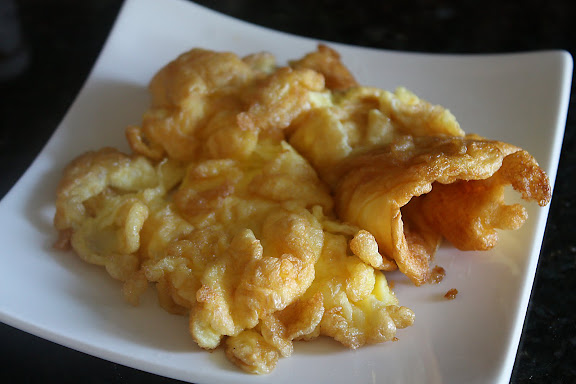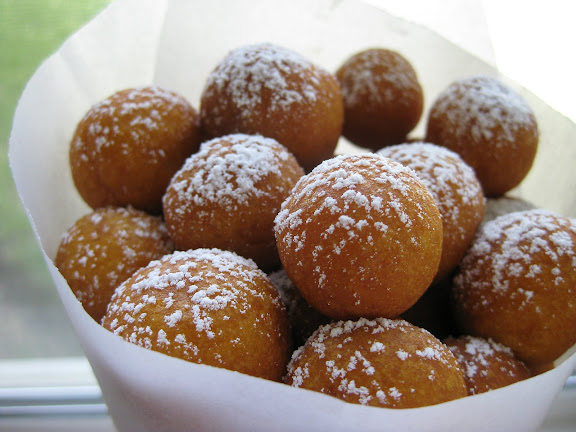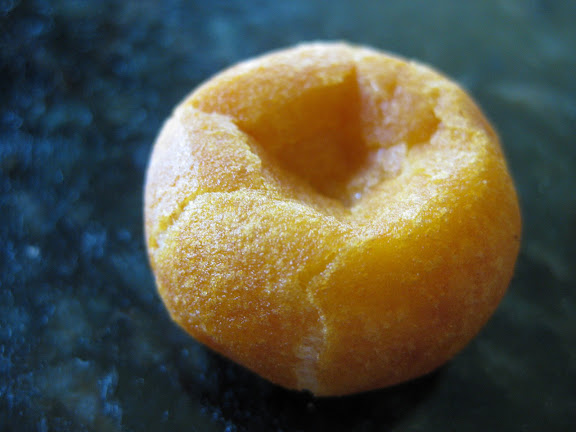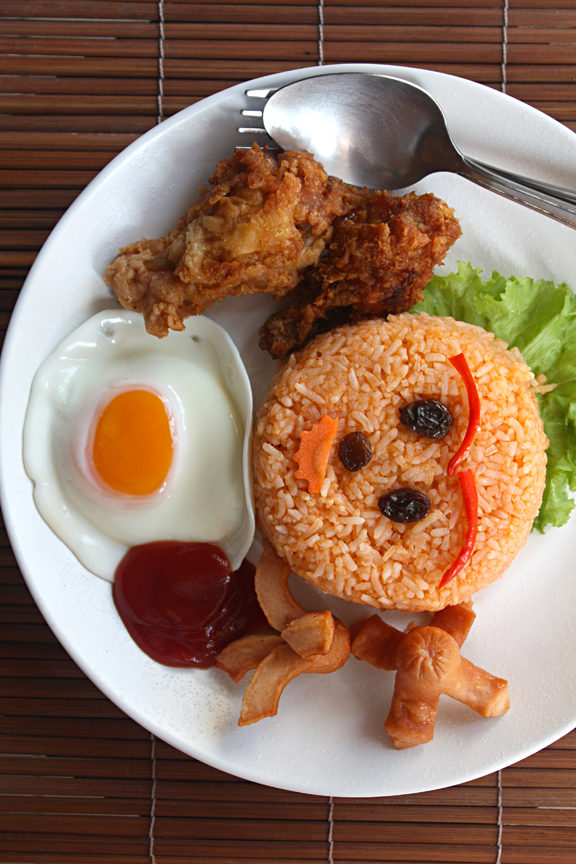
Imagine a bowl of soft and fluffy Jasmine rice. Perfectly cooked. Unadorned. Not piping hot; just a tad warmer than room temperature. Imagine a Thai omelet, a round of soft and fluffy eggy layers, hot and puffy off the wok, with its edges crispy and light as clouds over the rice. Then imagine a blessed anointing of Thai Sriracha on top of it all … My heartbeats are audible as I’m typing this. Continue Reading →
Archive | She Thais RSS feed for this section
Thai-Style Omelets (Khai Jiao, Khai Jeow, Khai Jiaw, ไข่เจียว)
Khanom Khai Nok Krata ขนมไข่นกกระทา – Thai Fried Sweet Potato Balls

Thai fried sweet potato balls – another one in the GFB-inspired series of fried goods. Please note that the light sprinkling of powdered sugar is my own heathen touch which you would never see done to this old-fashioned snack in the motherland. My fellow Thais, please accept my apology for this sacrilege. For those readers who are related to me, please don’t leave chastising messages on my voicemail.
This is another incident wherein sweet potatoes are used to replicate something that is originally made with Thai yams. This has resulted in the texture being a bit different and, due to the slightly higher sugar content, the exterior taking on a darker shade of brown more quickly in the frying pan. But I think these are delicious and quite close to what you would find on the streets of Bangkok.
Khanom Khai Nok Krata (ขนมไข่นกกระทา) is what we call these fried dough balls in Thai. The khanom (ขนม)part is, for lack of a better way to explain, an identity marker alerting your attention to the fact that the ‘thing’ whose name this word precedes belongs in the dessert/snack category. (I’m sure there’s a clearer and better way to explain it, but it eludes me at this moment.) Khai nok krata (ไข่นกกระทา) means quail’s egg – a telling moniker indicating the size of these little cuties. Though it’s difficult to tell from the pictures, each of these fried balls is indeed the size of a quail’s egg.
However, the similarity between these fried sweet potato balls and actual quail’s eggs extends beyond size; the outer shells of these fried balls, when pressed, collapse and crack in a similar manner to eggshells. When the dough balls hit the oil, they puff up a little. The inside becomes light and airy (almost hollow) whereas the outside forms very thin and crispy shell. The flavor is only mildly sweet. They are not exactly dessert, but more of a snack — something you pop into your mouth while strolling in the park.

According to one of the Thai cookbooks which I have inherited from my mother, the crispiness of these fried balls is due to the use of limestone water (a common ingredient in Thai kitchens back in the day when betel nut chewing was in vogue). To mimic the alkalinity of this ingredient which would be hard to find these days in Bangkok let alone Chicago, I used baking soda. In my perhaps biased opinion, though the end results aren’t as spectacular as the original, they are most definitely more than acceptable.
[Note added 5-22-09: As pointed out by Sandy, one of my commenters, please note that these fried sweet potato balls need to be consumed fresh off the wok. Sandy is absolutely right; they don’t keep at all and cannot be reheated. Thanks, Sandy!]

Khanom Khai Nok Krata ขนมไข่นกกระทา – Thai Fried Sweet Potato Balls
Makes approximately 120 3/4-inch balls
Printable Version
1 1/4 pounds sweet potatoes
1/3 cup sugar
1 teaspoon salt
2 cups tapioca starch
2 tablespoons all-purpose flour (Any gluten-free flour can also be used.)
2 teaspoons baking soda
Room temperature water
*For better results, omit baking soda and water and use limestone water instead.
American Fried Rice (ข้าวผัดอเมริกัน) and the Dead Sea Scrolls

Interestingly enough, the day I made this fried rice was the day Time magazine published this report. For those who don’t want to follow the link to the article, here’s my synopsis. An Israeli scholar, Rachel Elior, has proposed that the Qumran documents, aka the Dead Sea Scrolls, weren’t authored or copied by a religious group called the Essenes as traditionally believed.
According to Elior, both internal and external evidence points to the fact that the Essenes never existed. And since it’s inconvenient at best and impossible at worst for someone to write something unless they, well, exist, some theorists maintain that the group, famous for their ascetic lifestyle and extensive rules governing their bathroom rituals, could not have been responsible for the production of the Qumran documents. Continue Reading →
Enter your email to subscribe:
ARCHIVES
-
 Subscribe to The Epestle to Receive New Posts
June 30, 2021
Subscribe to The Epestle to Receive New Posts
June 30, 2021
-
 Introducing THE EPESTLE
February 13, 2021
Introducing THE EPESTLE
February 13, 2021
-
 Bury Me in Nam Phrik: Mike Sula’s Exploration of Thai Relishes (Plus Salted Soybean-Pork Rind Relish Recipe)
May 1, 2018
Bury Me in Nam Phrik: Mike Sula’s Exploration of Thai Relishes (Plus Salted Soybean-Pork Rind Relish Recipe)
May 1, 2018
-
 Food and Cooking in Thai TV Dramas, Love Destiny, 17th Century Siam, and Crispy Noodle-Wrapped Pork Dumplings
April 2, 2018
Food and Cooking in Thai TV Dramas, Love Destiny, 17th Century Siam, and Crispy Noodle-Wrapped Pork Dumplings
April 2, 2018
-
 A Simple Thai Dipping Sauce
March 12, 2018
A Simple Thai Dipping Sauce
March 12, 2018
-
 Northern Thai Rice Noodle Soup with Pork Ribs, Dried Cotton Flowers, and Tomatoes (Khanom Jin Nam Ngiao)
September 1, 2017
Northern Thai Rice Noodle Soup with Pork Ribs, Dried Cotton Flowers, and Tomatoes (Khanom Jin Nam Ngiao)
September 1, 2017
-
 How to Prepare Rice Vermicelli (Khanom Jin) from Dried Noodles
August 29, 2017
How to Prepare Rice Vermicelli (Khanom Jin) from Dried Noodles
August 29, 2017
-
 How to Prepare Pomelos for Thai Pomelo Salad
May 23, 2017
How to Prepare Pomelos for Thai Pomelo Salad
May 23, 2017











